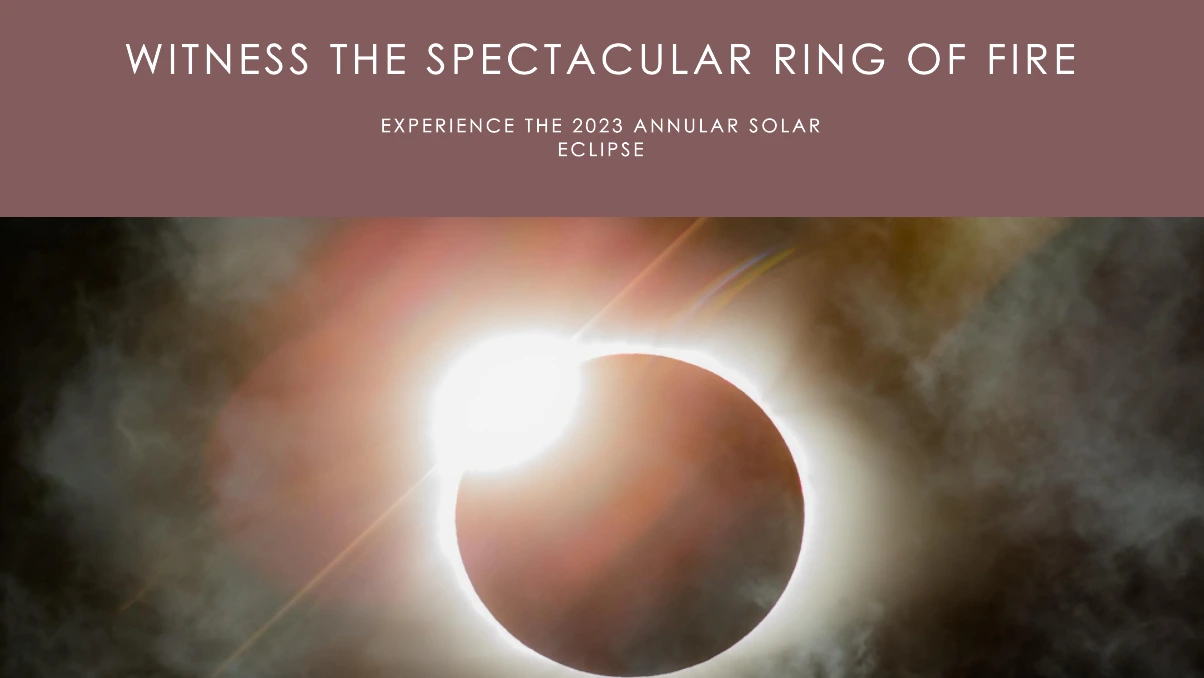| Event | Date | Visibility |
| Annular Solar Eclipse | October 14, 2023 | Southwestern United States and Central America |
The celestial wonders that the universe offers never cease to amaze us. One of the most captivating events in astronomy is a solar eclipse, and in 2023, there’s a particularly intriguing one on the horizon – the annular solar eclipse. In this blog, we’ll delve into the details of this celestial spectacle, including the date, time, and how to safely view it.
Understanding the 2023 Annular Solar Eclipse
What is an Annular Solar Eclipse?
Before we dive into the specifics of the 2023 annular solar eclipse, it’s essential to understand what this phenomenon is. An annular solar eclipse occurs when the moon comes between the Earth and the sun, but it doesn’t completely cover the sun. This leaves a brilliant ring-like appearance around the moon, often referred to as the “ring of fire”.
The Date and Time
The 2023 annular solar eclipse is a date that astronomers and skywatchers have circled on their calendars. It’s a rare celestial event, and knowing when and where to witness it is crucial.
Date and Visibility
- Date: The annular solar eclipse is set to take place on October 14, 2023.
- Visibility: This eclipse will be visible from a significant portion of the Southwestern United States and Central America.
Timing
- The specific timing of the eclipse may vary depending on your location. It’s essential to consult local astronomical resources or websites for precise timing in your area.
- Typically, solar eclipses are relatively short events, with the “ring of fire” phase lasting only a few minutes. It’s vital to be at the right place at the right time to witness this awe-inspiring sight.
Safety Precautions for Solar Viewing
While a solar eclipse is a remarkable spectacle, it’s crucial to remember that looking directly at the sun can be harmful to your eyes. Special precautions must be taken when viewing a solar eclipse.
Safety Precautions for Solar Viewing
| Safety Precaution | Why It’s Important |
| Use Solar Viewing Glasses | Ordinary sunglasses are not adequate and may result in eye damage. Solar viewing glasses offer the necessary protection. |
| Follow NASA and NSF Guidelines | These organizations provide expert guidance for safely viewing the eclipse. Following their advice is crucial for eye safety. |
Importance of Eye Protection
- Ordinary sunglasses are not sufficient for safely viewing a solar eclipse. The intense solar radiation during an eclipse can cause severe eye damage.
- To protect your eyes, use solar viewing glasses or other suitable filters specifically designed for observing the sun. These are equipped with a special coating that blocks harmful rays.
NASA and NSF Guidelines
- NASA and the National Science Foundation (NSF) provide comprehensive guidelines for safe solar viewing. It’s essential to follow these recommendations to ensure a safe and enjoyable eclipse experience.
Joining Educational Events
For astronomy enthusiasts and those eager to learn more about the 2023 annular solar eclipse, there are opportunities to participate in educational events.
Educational Events
| Event | Details |
| NASA’s Live Broadcast | NASA offers a live stream of the eclipse, allowing viewers to witness the event from the comfort of their homes. |
| NSF’s Educational Events | The NSF conducts educational events that provide insights into the eclipse and the science behind it. |
NASA’s Live Broadcast
- NASA regularly conducts live broadcasts during significant celestial events. For the 2023 annular solar eclipse, they will provide a live stream, offering viewers a front-row seat to this mesmerizing spectacle.
NSF’s Educational Events
- The National Science Foundation (NSF) also hosts educational events related to solar eclipses. They offer a chance to engage with experts, learn more about the eclipse, and appreciate the science behind this celestial occurrence.
Conclusion
The 2023 annular solar eclipse promises to be a breathtaking celestial event. With the “ring of fire” shining in the sky, it’s a sight that’s not to be missed. Remember to prioritize safety by using appropriate eye protection, and consider joining educational events hosted by NASA and the NSF to enhance your understanding of this spectacular astronomical event. Mark your calendars and get ready to witness the beauty of the universe in action.
